|
Organic Gardening
|
A sticky band of compound
This compound can be commercial products in the form of Tanglefoot or Stickem. They are a safe natural sticky compounds that can be used as a trap or barrier.
Abdomen
The abdomen is the hind section of the three main body divisions of the insect.
It functions as a storing and processing of the nutrients, the circulation of the blood, the pumping of oxygen, the development of eggs and their deposition and the production of sperm and copulation. The abdomen is flexible and is able to expand and contract.
African
Decollate Snails
These snails feed on the common brown garden snail, but generally leave organic garden crops alone. They are sold commercially, but some counties restrict their use.
Check with your local county extension agent for sources and possible restrictions.
Alfalfa
A deeply rooted, ragged and course, European plant that is rich in nitrogen (leguminous) and is usually grown for hay and forage, but can be used as mulch as well.
alkaloid
Any of class of saturated nitrogenous organic bases, especially one of vegetable origin, having a physiological affect on warm-blooded animals as strychnine or morphine.
Top of Insect Glossary A-D
alternative
host plant
Often, a predator or parasitoid of a fruit pest also attacks other insects that feed on other plants.
These alternative host insects usually cause no damage (economic) to the main crop, but are essential for the predator or parasitoid to overwinter or to complete its Life cycle. If this is the case then intercrop with alternative host plants in or near the organic garden or orchard.
An example of parasitoid conservation through intercropping alternative host plants takes place in vineyards where wild blackberries are allowed to grow. The Grape Leafhopper (Erythroneura comes), which is a serious pest of Grapes is attacked by a Chalcidoid (Wasp) egg parasitoid. This parasitoid over winters successfully only if an alternative host insect (non-pest) Leafhopper species that inhabits blackberries, is present.
Antenna
Antenna (pl. Antennae) are a pair of "feelers", located on the head above the mouthparts, and are used as sensory organs. The size and form of the antennae vary significantly among different insect groups and is useful in identification.
Top of Insect Glossary A-D
Aphids
Aphids are a small, sluggish, soft-bodied insect that uses its beak to pierce the plant and suck on the sap.
They often cause the spread of virus diseases from their puncture. Aphids are eaten by Lady Beetles, Green Lacewing and some Flower Fly. They are 1/16 to 1/3 inches long and pear shaped. The more than 800 species of Aphids have various life cycles and are found throughout North America and Europe.
Aphid
Aphids are a small, sluggish, soft-bodied insect that uses its beak to pierce the plant and suck on the sap.
They often cause the spread of virus diseases from their puncture. Aphids are eaten by Lady Beetles, Green Lacewing and some Flower Fly. They are 1/16 to 1/3 inches long and pear shaped. The more than 800 species of Aphids have various life cycles and are found throughout North America and Europe.
Top of Insect Glossary A-D
arachnids
A group of terrestrial arthropods that consists of Harvestmen, Mites, Pseudscorpions, Scorpions, Spiders, and Whipscorpions.
With the exception of Mites, most arachnids are predators.
Arolium
The arolium is the pad between the tarsal claws or at the base of each tarsal claw.
Top of Insect Glossary A-D
augmentation
Augmentation of predators and parasitoids involves the culture and repeated release of natural enemies to stifle pest populations. They may naturally occur, but only at low populations or may be an exotic species that are not able to carry on in the new environment. An example might be the release of the parasitoid Trichogramma Wasp, which attacks the eggs of 200 insect pests. This parasitoid is most effective when it is released in a sequence of three releases at two-week intervals. In colder regions, it may die out.
axils
The axil of a plant is the angle formed by the branch or leaf and the axis from which it originated, or in other words, at the base of a branch or leaf.
Top of Insect Glossary A-D
Bacillus
thuringiensis
Bacillus thuringiensis, or Bt, is a naturally occurring bacterial disease organism and is one of the most effective insecticides used today, especially against Caterpillars. Bt is commercially available in dust or spray for use throughout your organic garden and is nontoxic to mammals and birds. In fact, if used as directed, it can be used close to harvest time.
Bacterial Wilt
Bacterium
Plant infested with Bacterial Wilt will wilt and become slightly stunted. On stems, brown, soggy streaks and lesions may appear, and dark ooze may be evident. Potato tubers often show a darkened vascular ring about 1/3 inch below the skin.
Top of Insect Glossary A-D
Barriers
and traps
Barriers prevent the insect from attacking foliage from climbing or flying insects. I suggest many types of traps in the insect listings. Barriers:
1. Cover plants with nylon netting
2. Bone
meal
3. Copper
bands around trunks against Slugs and Snails
4. A
sticky band of compound - Tanglefoot
and Stickem
5. Intercropping
with plants that provide physical interference to insect pests
Insect Traps:
a. Black light traps
b Temporary debris traps, i.e. boards, bamboo sections
c. Intercropping with trap plants
Beetles
There are many varieties of beetles, or insects belonging to the Coleoptera order, characterized by having four wings of which the outer pair is modified into rigid coverings to protect the inner pair when not in use.
Berries and Grapes Berries and Grapes
Blackberry Blueberry
Boysenberry Currant
Gooseberry Grape
Raspberry Strawberry
Top of Insect Glossary A-D
Beneficial Insects
black leg
Bacterium
Stems are blackened and look slightly rooted near the soil line. Leaves turn yellow and curl upward before dropping off. Potato tubers can become infected at the stem end and appear soft and rotted. Infected fruit become water-soaked with dark spots.
This disease is transmitted by the soil, seeds, insects and cutting or pruning tools. An effective control is rotating the particular crop every four or five years.
Top of Insect Glossary A-D
Black
light traps
Black light traps are traps that use a form of black light that is visible or perceptible to certain insects as a form of attractant. The insects are drawn toward the light and are usually electrocuted when they arrive at the trap.
Bone Meal
Top of Insect Glossary A-D
Borers
Borers are the larvae of insects, which tunnel into the wood of trees and shrubs and the stalks of plants. The adults lay eggs on the plant or may plunge them into plant tissue. Upon hatching, the borers spend most of their lives within the plant, and can do a significant amount of damage before it is noticed.
Stress from drought, nicked trunks from lawn mowers, freezes, wind and fire make plants very susceptible to Borer attack. Ways to protect plants from borers:
- Work on keeping a healthy soil and don't over fertilize.
- Consider the water requirements of each plant, and stay within those limits.
- Wrap strips of barrier materials around the trunks of trees,
i.e. burlap, Tanglefoot, Stickem, and cardboard.
- Use proper pruning techniques to remove injured, or weakened branches of trees.
- Look carefully for small entrance holes in the bark or just above the soil on the trunk. There may be sap oozing or brown castings around the hole.
Unfortunately, once borers infested the plant they may be very hard to eliminate.
Boron (B)
Boron levels are low in many parts of the U.S. due to leaching from the soil. Attempts to correct low levels may often be difficult in soils low in organic matter. Many crops are very sensitive to a boron deficiency, including apples, beets, turnips, muskmelons, broad beans, onions, cabbage, lettuce, carrots, other fruit trees, and some legumes.
Boron plays a major role in photosynthesis, seed setting, and the viability of pollen. Boron can be very toxic and should be applied evenly and in the proper amount.
botanicals
The word botanical simply means "relating to plants," therefore, when used in conjunction with an insecticide, it means the insecticide has been derived from plants, or can be considered a natural or organic insecticide.
Top of Insect Glossary A-D
Braconid
parasite
A Braconid parasite refers to the tiny Braconid Wasp, which is a parasitic insect that attacks Caterpillars. The adult wasp lays its eggs on caterpillars, or host insects. The eggs produce tiny larvae that eat into the caterpillar, eventually killing the host insect. If you see caterpillars with many tiny white eggs on the surface, do not destroy the insect, instead let the Braconid wasp do its work. They are very useful insects and should be encouraged in your organic garden. They can also be purchased commercially. See your local nursery.
brood
A brood is a group, in these case insects, having the same origin. A brood of insects refers to a group of insects that were hatched at the same time or during the same time of the year.
Top of Insect Glossary A-D
brown rot
Brown rot is a disease found in stone fruits, such as peaches,
and is caused by fungi. Brown rot can be prevented by placing the
freshly picked fruit in a hot water bath of 120 deg. F for
7 minutes, or 140 deg F for 2 minutes. It is most effective to perform
this within 24 hours of harvest, but has been found to work even when
this isn't possible.
Bugs
Bugs range in size from minute to very large and are easily recognized by the wings and shape. The mouthparts are piercing sucking type, consisting of a three or four-part beak (the labium is elongated) enclosing the mandible and maxilla in the form of pointed side arms. The mouthparts arise from the front part of the head
Bugs are mostly plant eaters. They pierce the outer surface of fruits and plant tissue and inject salivary fluids to draw out and consume partially digested cell sap. Bug damage results in blemished and pitted fruits and foliage. Sudden wilting may also occur.
Cleaning garden debris and weed control are the best preventive measures in controlling these pests. rotenone, sabadilla, and ryania may be effective, but only as a last resort.
Some of the most important pest predators are Bugs, such as the Assassin Bugs , Ambush Bugs, Damsel Bugs, and certain Stinkbugs.
Top of Insect Glossary A-D
Bulb
Chive GarlicLeek Onion
Shallot
Calendula
Calendula is a yellow-rayed herb that grows well in temperate or mild temperature regions.
Top of Insect Glossary A-D
Calcium (Ca)
Calcium is needed to build plant cell walls and encourage tissue growth. Calcium occurs naturally in organic soil; in most cases, supplements are not required. However, if your soil is extremely acid, you may need to amend the ph level. High amounts of acid deplete the calcium in soil.
Calcium is one the most important nutrients in the soil and in the plant. In the soil, it binds both inorganic and organic substances and thereby plays a major role in the of good soil structure. In the plant, calcium helps regulate the transport of nutrients across plant cell membranes. Calcium also protects the plant from the harmful waste products of plant metabolism.
Top of Insect Glossary A-D
camouflage
Camouflage is the concealment by means of disguise. For example, some insects look like sticks and are difficult to see when in trees or shrubs.
Cankerworms
There are two types of cankerworms, more commonly known as
"Inchworms," spring cankerworms and fall cankerworms.
Cankerworms will climb shade or fruit trees to feed on the foliage and will travel from tree to tree or descend to the ground for hibernation by swinging on a silk strand that it produces. The cankerworm has many natural enemies, such as, birds, Tachinid Flies, Ground Beetles, potter wasps, and other predatory insects. They can also be controlled by proper soil cultivation, since they hibernate just under the surface of the soil. The cankerworm is about an inch long and matures into a male moth or a wingless female insect.
Top of Insect Glossary A-D
Caterpillar
A caterpillar is a wormlike larva of a moth or butterfly.
Cation-Exchange Capacity
Cation-exchange capacity is the degree a soil can adsorb and exchange cations.
Soil particles and organic matter have negative charges on their surfaces. Mineral cations can adsorb to the negative surface charges or the inorganic and organic soil particles. Once adsorbed, these minerals are not easily lost when the soil is leached by water and they provide a nutrient reserve available to plant roots. These minerals can then be replaced or exchanged by other cations (i.e., cation exchange)
Cation-exchange capacity is dependent upon soil texture and organic matter content. More there is of clay and organic matter in the soil the higher the Cation-exchange capacity. Clay content is important because these small particles have a high ration of surface area to volume.
catnip
Catnip is an aromatic mint, Nepeta Cateria, with spirals of small pale flowers and contains a substance that is attractive to cats.
Top of Insect Glossary A-D
Cervix
The cervix is the large membranous neck region of the insect, between the head and thorax.
Chalcid Wasp
The Chalcid Wasp is a very tiny insect that is parasitic as a larva on or in the larvae or pupae of other insects. In other words, it lives and feeds, by attaching itself to a host insect to the eventual destruction of that host insect.
Top of Insect Glossary A-D
cheesecloth
Cheesecloth is a very lightweight cotton cloth used in the making of cheese, but is very popular among some organic gardeners as a form of pest control. For example, to guard against cabbage maggots, gardeners will make a cheesecloth tent over the cabbage. The cheesecloth used is usually made with at least 24 strands per inch and covers the garden patch completely, extending 6 inches all the way around. The tent is usually allowed to remain until the plant is passed the seedling stage and has formed healthy roots. The only draw back to the tent is that it provides shade and slows the growth of the plants.
Top of Insect Glossary A-D
chewing damage
It's important to look for signs of insect attack. The signs may show up as leaf or foliage or crown damage. Types of damage are:
1. Leaves chewed from outside edge
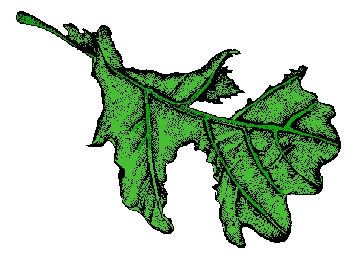
2. Leaves with speckles or speckles and may be chewed
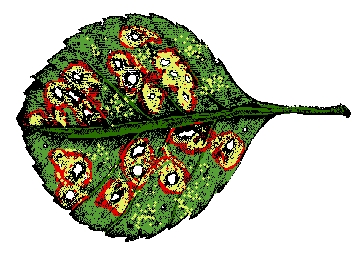
3. Leaves are chewed in the inside
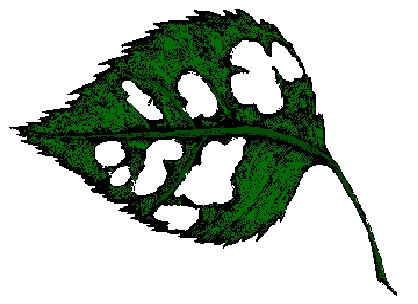
4. Leaves are skeletonized
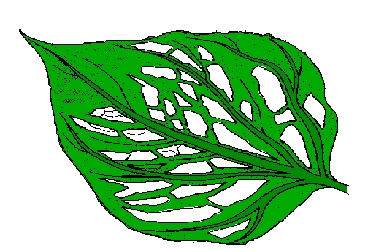
5. Leaves have tunnel marks
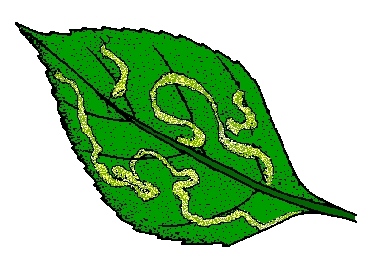
6. Leaves may be surrounded in webs
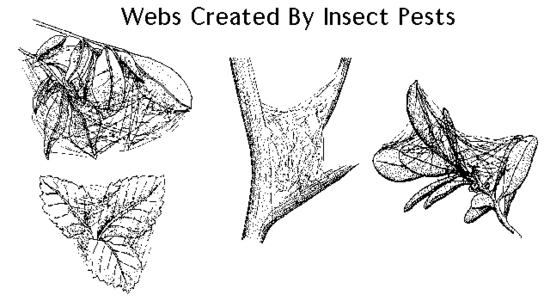

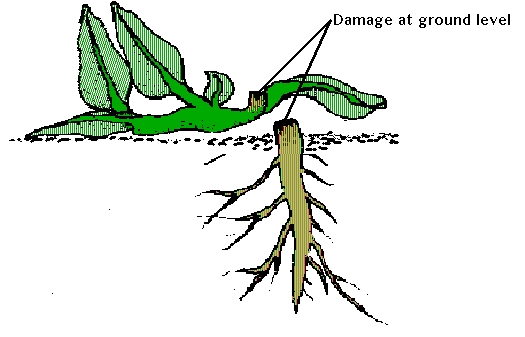
Top of Insect Glossary A-D
Chickens
If you live in a rural area and have chickens, you may periodically allow your chickens to browse your organic garden. They will consume Slugs and Snails as fast as they can find them. You may have to water first to bring the Slugs and Snails out.
Top of Insect Glossary A-D
Cicada
The periodical Cicada is a stout, 1-inch long insect with a short blunt head, red bulging eyes, and transparent wings. The male makes a buzzing noise by vibrating its membranes at the base of its abdomen. There are two types of Cicadas. The Dog-day Cicada appears annually and has a black body, green wings, and numerous white markings. The periodical Cicada takes 13 to 17 years to mature under the soil, then emerges for 6 weeks as an adult to reproduce.
Top of Insect Glossary A-D
chlorophyll
Chlorophyll is a green pigment found in most plants. Chlorophyll is vital for photosynthesis, which helps plants obtain energy from light. It absorbs light and transfer that light energy to the plant.
Top of Insect Glossary A-D
classification
I have chosen to break up food crops into the following classification: Orchard crops Nut Fruit Berries and Grapes
Classification of vegetables is based on use and botany Vegetables Bulb Cole (all are members of Bassisca oleracea except and including Chinese Cabbage) Corn Cucurbits (all members of the Cucurbitacea) Fleshy Fruits (members of the Solanacea) Grains Perennials (those plants that grow back year after year for three or more years) Legume Roots Salad
Top of Insect Glossary A-D
Claws
In most instances, the claws are used to grip onto normally rough surfaces.
Top of Insect Glossary A-D
clover
Clover is a low growing leguminous, or nitrogen fixing, herb with a three leaf stalk and is often used as a ground cover or lawn. The clover flowers in a dense head and is very attractive to bees.
Top of Insect Glossary A-D
Clypeus
The clypeus is located just below the fronds and above the labium and serves as the attachment for the labium.
Cole
(all are members of Bassisca
oleracea except Chinese
Cabbage)
Broccoli Brussels sprouts
Cabbage Cauliflower Chinese Cabbage Kohlrabi
Coleoptera
Coleoptera is the order of Beetles and are the most diverse group of insects. The Beetle order has more species in it than in any other order in the animal kingdom.
Top of Insect Glossary A-D
compost
Compost is a mixture consisting mainly of decaying organic matter, which is used for fertilizing crops, gardens, and yards.
Most organic gardeners designate an area where all garden rubbish is stored and allowed to decompose into a rich organic fertilizer.
For more information on organic gardening composting see Organic Gardening Compost
Top of Insect Glossary A-D
compound eyes
The compound eyes are located on the head and are made up of many individual facets; the facets represent types of lenses and may be hexagonal or circular. In many insects, the compound eyes take up a considerable area of the head.
Top of Insect Glossary A-D
conservation
Conservation of predators and parasitoids is used to preserve the naturally occurring beneficial insects in the garden. Conservation involves the special consideration when applying natural insecticides (Rotenone or Pyrethrum) that may kill the beneficial insects and creating an environment that is well suited for them. This environment is created by intercropping with plants that provide nectar to adult predators and parasitoids or helps the beneficial to overwinter.
Conservation Guidelines of Predators and Parasitoids:
1. Intercropping with Insectary plants
2. Supply
artificial food
3. Intercropping with an alternative
host plant
Copper
Copper is very important to the reproductive process of plants. It improves yield and prolongs storage life most noticeably in root and leaf crops. In many parts of the country, copper levels are decreasing to the point of deficiency.
Top of Insect Glossary A-D
Copper bands
Wrap bands of copper around the trunks of trees.
Slugs and Snails will not cross this barrier.
coxa
The most basal segment of the insect leg, articulating with the thorax. The coxa acts as the pivoting joint.
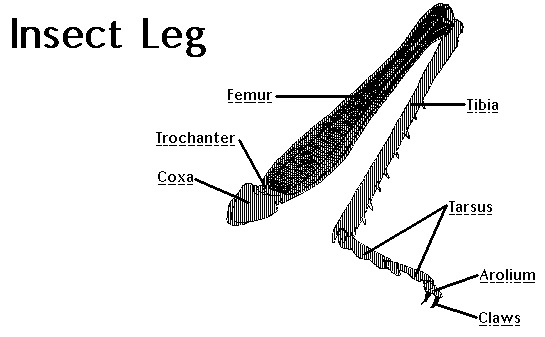
Top of Insect Glossary A-D
creosote
Creosote is a yellow or clear oily liquid of phenolic ingredients and is very flammable. Creosote is made from the process of beech wood tar distillation.
Top of Insect Glossary A-D
cucumber
mosiac
Cucumber mosaic is a viral disease common to cucumbers that is transmitted by aphids. The disease produces blotchy foliage and often affects the fruit by turning it pale and warty.
Top of Insect Glossary A-D
Cucumber Wilt
Cucumber Wilt, Bacterial Wilt
Bacterium - Erwinia tracheiphila
Cucumber Wilt infects all Cucurbits, except Watermelon. This disease causes the leaves to have patches of discoloration and eventual wilt. The plant may wilt so fast that the leaves may both dry up and remain green. The bacteria are spread by the Spotted and Striped Cucumber Beetles.
Affected plants should be destroyed immediately.
Cover the uninfected crops with cheesecloth or floating row covers to keep the Beetles from spreading the disease even more.
Controlling the Spotted and Striped Cucumber Beetles, and crop
rotation
(Beetles overwinter
in soil)
are the best ways of controlling Cucumber Wilt.
Cucurbits Cucurbits
(all members of the Cucurbitacea)
Cucumber Gourd Melon
Muskmelon Pumpkin
Squash Watermelon
Top of Insect Glossary A-D
culls
Culls are rejected or worthless items, such as, infected or rotten fruit, branches, or foliage.
Top of Insect Glossary A-D
Cultivate
Cultivate means to loosen, break up, or turn over soil in preparation for raising crops.
Top of Insect Glossary A-D
Cultivating
Cultivating is the act of loosening, or turning over soil in preparation for raising crops.
Top of Insect Glossary A-D
Cultivation
Cultivation is the act of loosening, or turning over soil in preparation for raising crops.
Top of Insect Glossary A-D
debris
Garden debris is organic matter, such as, garden rubbish or trash, pruning's, clippings, or fallen fruit.
If debris is spread through out the garden, it may shelter and encourage pests and encourage disease.
Almost all garden waste should be placed in the compost pile.
Top of Insect Glossary A-D
defoliate
Defoliate means to deprive of leaves, usually prematurely. For example, some insects can strip plants of their leaves by eating them, such as grasshoppers.
Top of Insect Glossary A-D
diapause
Diapause is the period of dormancy, such as with certain insects, that occurs between periods of activity.
Top of Insect Glossary A-D
Diatomaceous
earth
Diatomaceous earth is made from the ground skeletons of small-fossilized animals. When soft-bodied insects and non- insects such as Aphids, Grubs, Caterpillars, Fly maggots, Mites, Slugs or Thrips eat it, it punctures their stomachs. This causes the insect to die from dehydration.
It perhaps is the safest and most effective contact natural insecticide, but is very expensive and a scarce environmental resource.
Top of Insect Glossary A-D
dipterous
A dipterous insect is one that has two wings, such as a two-winged fly.
Top of Insect Glossary A-D
dormant oil
Dormant oils get their name because they are generally used when plants are in the dormant stages of the season. Safe dormant oil would consist of light grade oil and an emulsifier, such as fish-oil soap. Application of the oil is usually just prior to the buds opening. Dormant oils are carried by most garden supply stores. Do not use dormant oil sprays that contain arsenate of lead, lime sulfur, or any other strong chemicals used to increase the insecticidal strength. They are definitely harmful to your plants and are not safe to use.
Top of Insect Glossary A-D
Dust
with Diatomaceous earth
Dust with Diatomaceous earth. This method is very effective.
Back to the top Retun from Insect Glossary A-D to Insectipedia